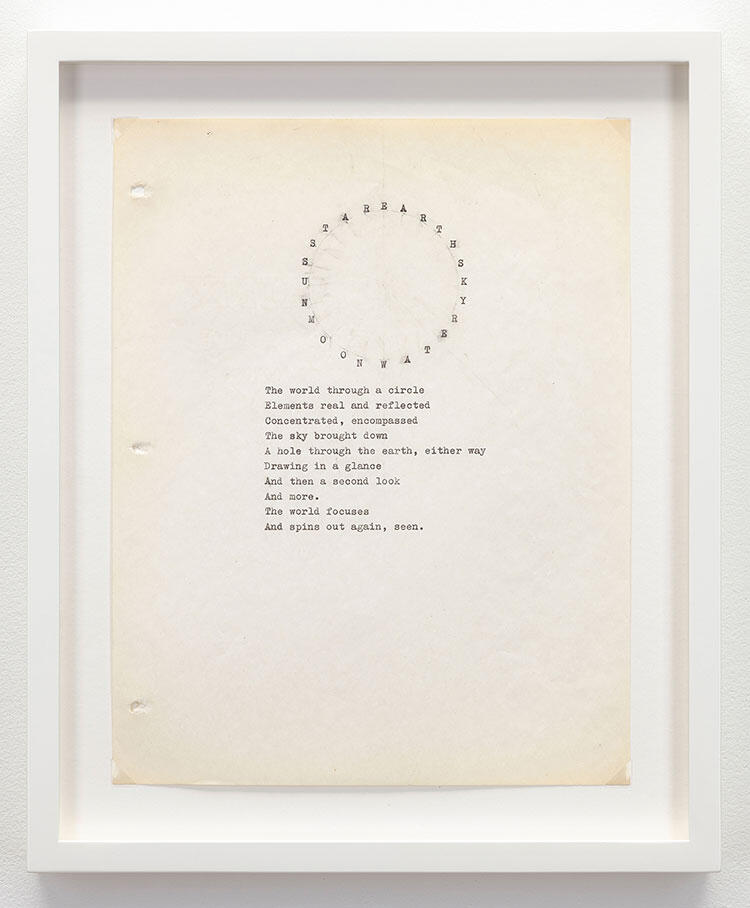Was Nancy Holt a Feminist or a Mystic?
A posthumous retrospective of the artist’s work at Bildmuseet, Umeå, aims to redress the art-historical record
A posthumous retrospective of the artist’s work at Bildmuseet, Umeå, aims to redress the art-historical record

‘Inside Outside’, Nancy Holt’s first major European retrospective, is an expansive survey that raises under-explored questions about the artist’s work. Most closely associated with the land art movement, Holt is best known for her large-scale earthworks, including the monumental Sun Tunnels (1973–76): four concrete cylinders which frame the rising and setting sun during the winter and summer solstices installed in Utah’s Great Basin Desert. Although these works are well represented, it is the artist’s lesser-known pieces that surprise and show the full extent of her inquiry into systems, time, space and location.

Spanning five of Bildmuseet’s seven floors, the exhibition gives ample room to Holt’s formative experiments, which include rarely exhibited films, photographic series and works on paper. In World Through a Circle (1972), for instance, a poem describing an artistic practice grounded in sustained observation rests beneath a ring of letters, which spell out ‘earth’, ‘sky’, ‘water’, ‘moon’, ‘sun’ and ‘stars’. Videos such as Going Around in Circles (1973), in which perforated boards mask the camera lens, visually echo the poem, as does a selection of Holt’s ‘Locators’ sculptures from the early 1970s: cylindrical devices whose apertures not only focus viewer attention but seem to literalize the often-unacknowledged processes of selection and framing upon which the discourses of site-specificity and land art rely.

One of these framing devices is gender, which the exhibition underscores in its stated attempt to redress the art-historical record. Though firmly in the canon, Holt has, until recently, played second-fiddle to her male counterparts, in particular her husband and land art figurehead Robert Smithson. Calling attention to the artist’s interest in the ‘concretization of perception’, a term Holt coined in the mid-1970s for perceiving one’s own perception, works such as Mirrors of Light I (1973–74), a room-sized installation featuring a diagonal line of mirrors refracting ellipses of light, not only suggest that her commitments to phenomenology differed from those of other land artists, but also hint, from today’s vantage, at a dialogue with feminist approaches focused on a critique of the male gaze.

In a further redress, the show invites us to consider Holt’s interest in making visible the hidden infrastructure and unseen labour, often undertaken by women, that support everyday life. For instance, the site-responsive sculpture Ventilation System (1985–92/2022) is a network of steel ducts connecting Bildmuseet’s interior to its exterior and intruding in the foyer and bookstore. Elsewhere, an early work on paper, Making Waves (1972), renders explicit the link to gender via a graph that jokingly charts how ‘feminist’, ‘artistic’ and ‘mystic’ Holt felt during a 24-hour period. On that day, her identification as a feminist increased in inverse proportion to her identification as an artist and, in turn, decreased with the ascension of her mystic self.

Yet, much as the exhibition strives to unearth the artist’s feminism, it is Holt the mystic who steals the show. Depicted here in stunning photographs taken in 1988 by Richard Misrach, the massive Sun Tunnels spin out in a complex temporal layering that is supported by a treasure trove of preparatory material, photographic studies and a captivating 16mm film documenting the production and installation of the work, which stands on the ancestral land of the Shoshone and Goshute Peoples. Although a footnote in the catalogue concedes that Holt’s conceptual rigour did not extend to the effects of settler-colonialism until her move to New Mexico in 1995, no mention is made of this in the exhibition itself, which feels like an oversight in a region where struggles over Indigenous land rights are increasingly visible.

Even so, Holt’s methodical intelligence and keenly honed poetics of place shine through. This generous offering recommends her work for further scholarship despite – or perhaps because of – its political limitations.
Nancy Holt’s ‘Inside Outside’ is on view at Bildmuseet, Umeå, until 12 February 2023.
Main image: Richard Misrach, Nancy Holt, Sun Tunnels, 1988, pigment print, documentation photograph. Courtesy: the artist
























